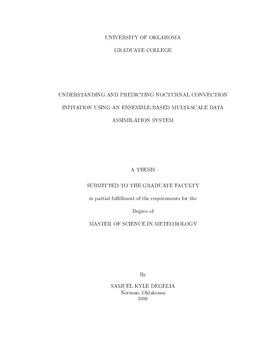| dc.description.abstract | A nocturnal maximum in precipitation exists over the Great Plains during the summer. The initiation of nocturnal storms is notoriously difficult to forecast in numerical models due to the storms often involving interactions across many scales. Additionally, most storms that develop at night are categorized as “elevated” in which the conditionally unstable source air is located above the boundary layer. While convection initiation (CI) in well-mixed, daytime boundary layers is often triggered along boundaries of surface convergence and is moderately well-understood, nocturnal CI is relatively unexplored. In this thesis, a multi-scale, GSI-based EnKF forecast system is applied to a case from 25 June 2013 to address the impact of (1) radar and conventional data assimilation; and (2) physical parameterization schemes on nocturnal CI forecasts. These results will be utilized to (3) improve the understanding of mechanisms that lead to nocturnal CI.
The simulated convection appears to have been generated by the interaction of synoptic scale lift, a surface outflow boundary, a veering nocturnal low-level jet (LLJ), and trapped gravity waves. The assimilation of conventional observations (surface, rawinsonde, aircraft, etc.) enhanced convergence at the terminus of the LLJ and strengthened ongoing convection that produced an important cold pool and resulting gravity waves. Radar assimilation showed little improvements in the CI forecast, though it better resolved earlier convection and reduced the amount of spurious precipitation. Additionally, little sensitivity was found for both planetary boundary layer and microphysical parameterization schemes. | en_US |
